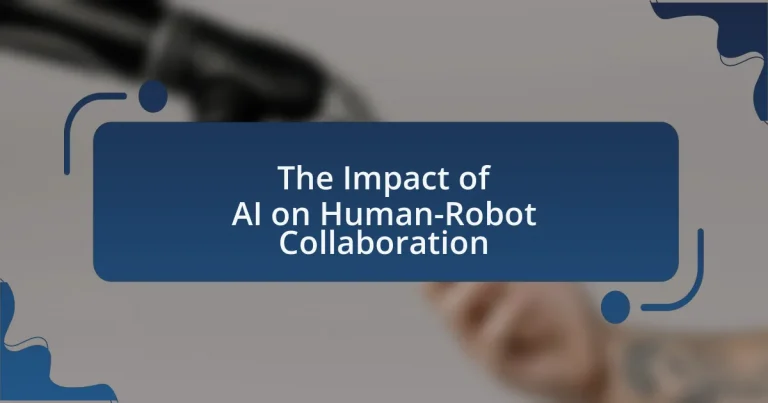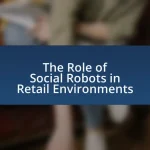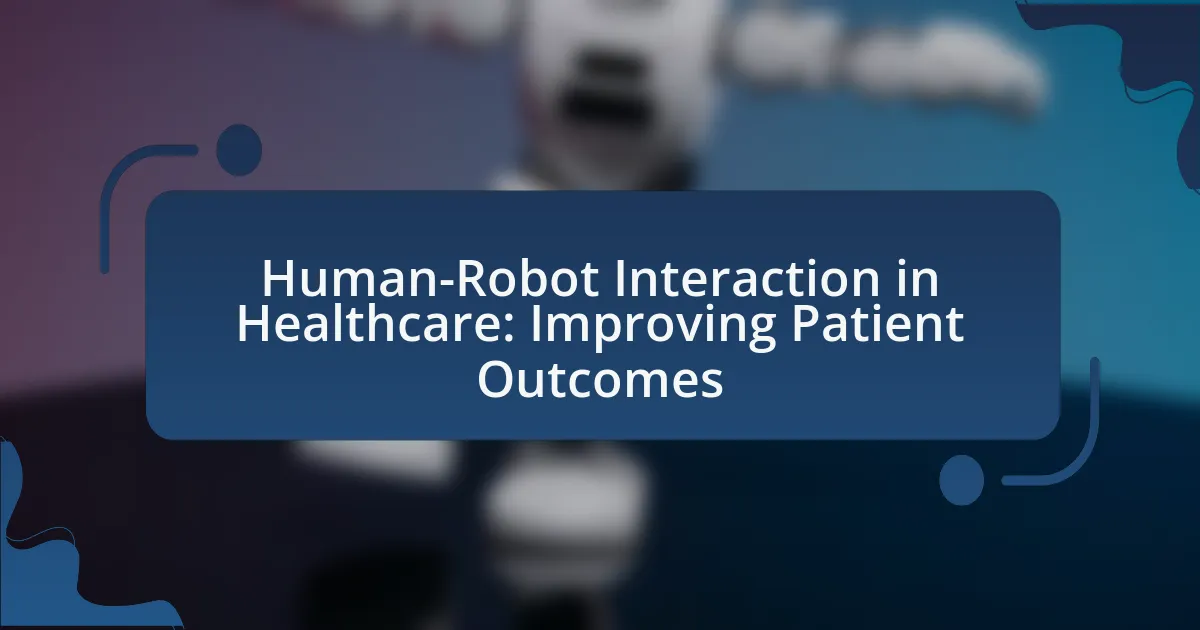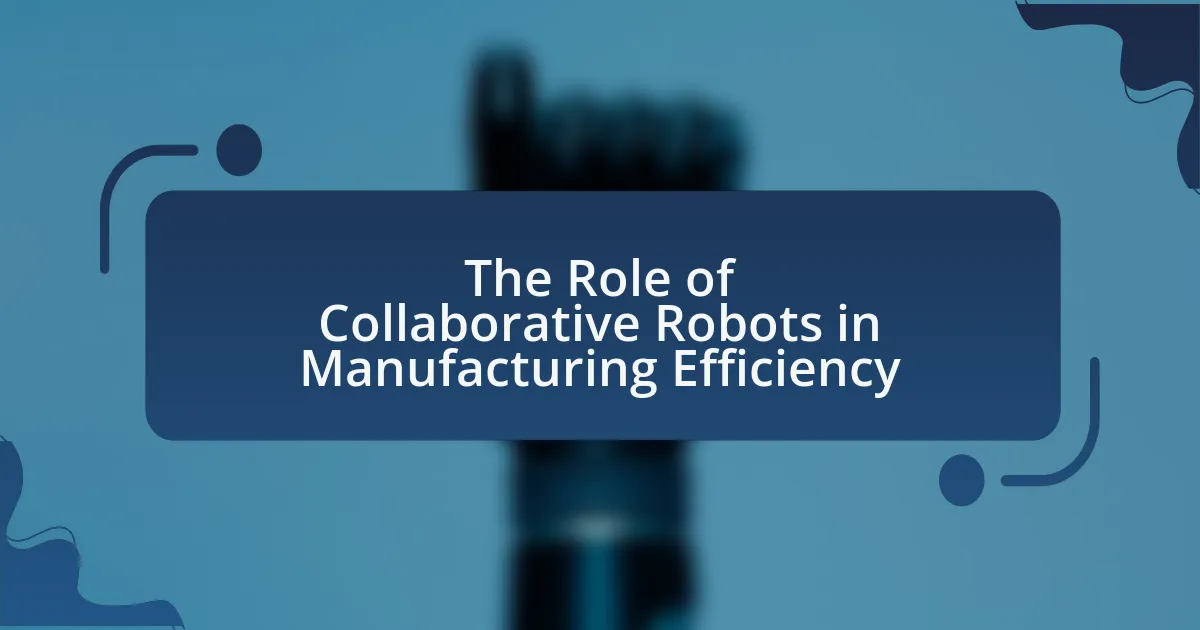The article focuses on the significant impact of artificial intelligence (AI) on human-robot collaboration, highlighting how AI enhances efficiency, safety, and adaptability across various sectors such as manufacturing, healthcare, and logistics. It discusses specific AI technologies like machine learning, computer vision, and natural language processing that improve robots’ decision-making and interaction capabilities with humans. The article also addresses the benefits of AI in optimizing workflows and increasing productivity, while acknowledging challenges such as communication barriers, safety concerns, and ethical dilemmas. Furthermore, it outlines practical steps organizations can take to implement AI effectively in collaborative environments, ensuring successful integration and training for human workers alongside robots.
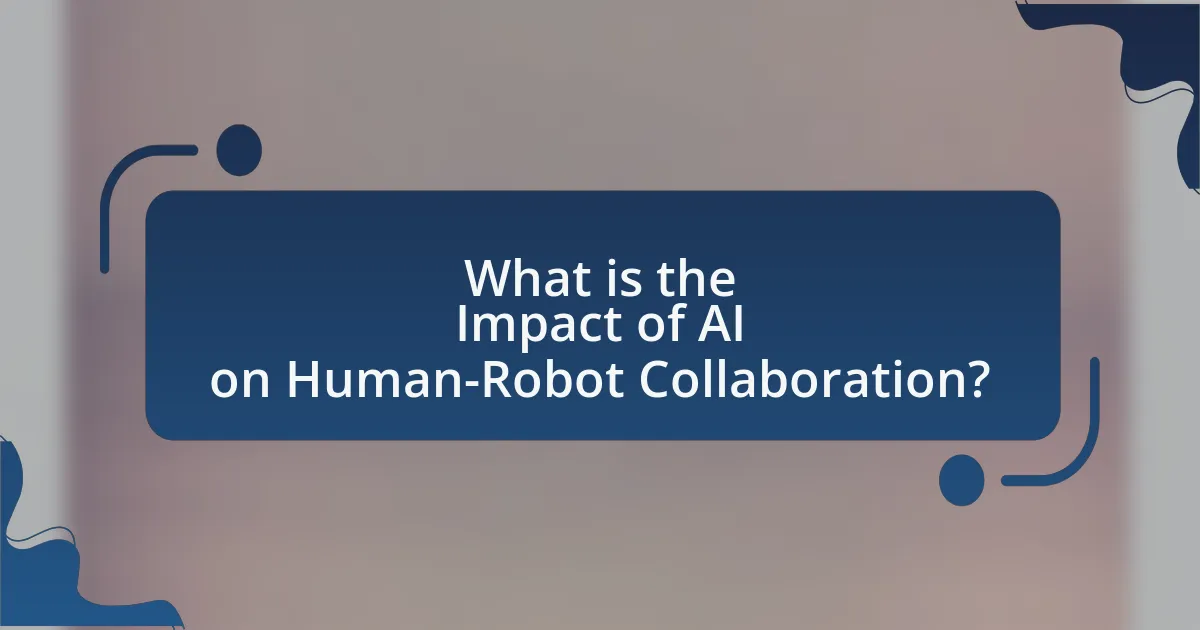
What is the Impact of AI on Human-Robot Collaboration?
The impact of AI on human-robot collaboration is significant, enhancing efficiency, safety, and adaptability in various environments. AI enables robots to learn from human interactions, improving their ability to assist in tasks such as manufacturing, healthcare, and logistics. For instance, a study by the Massachusetts Institute of Technology found that AI-driven robots can increase productivity by up to 30% in assembly lines by effectively collaborating with human workers. Additionally, AI enhances robots’ decision-making capabilities, allowing them to operate safely alongside humans by predicting and responding to their actions in real-time. This synergy between AI and robotics fosters a more productive and safer work environment, demonstrating the transformative potential of AI in human-robot collaboration.
How does AI enhance human-robot collaboration?
AI enhances human-robot collaboration by enabling robots to understand and respond to human actions and intentions more effectively. This capability is achieved through advanced machine learning algorithms and natural language processing, which allow robots to interpret human commands and contextual cues. For instance, research conducted by the Massachusetts Institute of Technology demonstrated that AI-driven robots could adapt their behaviors based on real-time feedback from human operators, leading to improved task efficiency and safety in collaborative environments. This adaptability fosters a more intuitive interaction between humans and robots, ultimately enhancing productivity and teamwork.
What specific AI technologies are utilized in human-robot collaboration?
Specific AI technologies utilized in human-robot collaboration include machine learning, computer vision, natural language processing, and reinforcement learning. Machine learning enables robots to learn from data and improve their performance over time, while computer vision allows robots to interpret and understand visual information from their environment. Natural language processing facilitates communication between humans and robots, enabling them to understand and respond to verbal commands. Reinforcement learning helps robots make decisions based on trial and error, optimizing their actions in dynamic environments. These technologies collectively enhance the effectiveness and efficiency of human-robot collaboration in various applications, such as manufacturing, healthcare, and service industries.
How do these technologies improve efficiency and productivity?
AI technologies improve efficiency and productivity in human-robot collaboration by enabling robots to perform tasks with greater precision and speed than humans. For instance, AI algorithms can analyze data in real-time, allowing robots to adapt to changing conditions and optimize their performance. A study by McKinsey & Company found that automation can increase productivity by up to 30% in manufacturing settings, demonstrating the tangible benefits of integrating AI with robotic systems. Additionally, AI enhances decision-making processes by providing insights derived from large datasets, which leads to more informed and timely actions in collaborative environments.
What are the key benefits of AI in human-robot collaboration?
The key benefits of AI in human-robot collaboration include enhanced efficiency, improved safety, and increased adaptability. AI enables robots to process data and learn from their environment, allowing them to perform tasks alongside humans more effectively. For instance, in manufacturing, AI-driven robots can optimize workflows by predicting maintenance needs, which reduces downtime and increases productivity. Additionally, AI enhances safety by allowing robots to monitor human actions and adjust their behavior to prevent accidents, as seen in collaborative robots (cobots) that work in close proximity to human workers. Furthermore, AI’s ability to adapt to changing conditions and learn from experience allows robots to handle a wider variety of tasks, making them more versatile in dynamic environments.
How does AI contribute to safety in collaborative environments?
AI enhances safety in collaborative environments by enabling real-time monitoring and predictive analytics. Through advanced sensors and machine learning algorithms, AI systems can detect potential hazards and assess risks, allowing for timely interventions. For instance, AI can analyze data from various sources, such as cameras and environmental sensors, to identify unsafe conditions or behaviors, thereby reducing the likelihood of accidents. Research indicates that AI-driven safety systems can decrease incident rates by up to 30% in industrial settings, demonstrating their effectiveness in promoting a safer collaborative atmosphere.
What advantages does AI provide in terms of task performance?
AI enhances task performance by increasing efficiency, accuracy, and consistency in various operations. For instance, AI algorithms can process vast amounts of data rapidly, enabling quicker decision-making compared to human capabilities. A study by McKinsey & Company found that AI can improve productivity by up to 40% in certain sectors by automating repetitive tasks and minimizing human error. Furthermore, AI systems can learn from past performance, continuously optimizing processes and adapting to new challenges, which leads to improved outcomes over time.
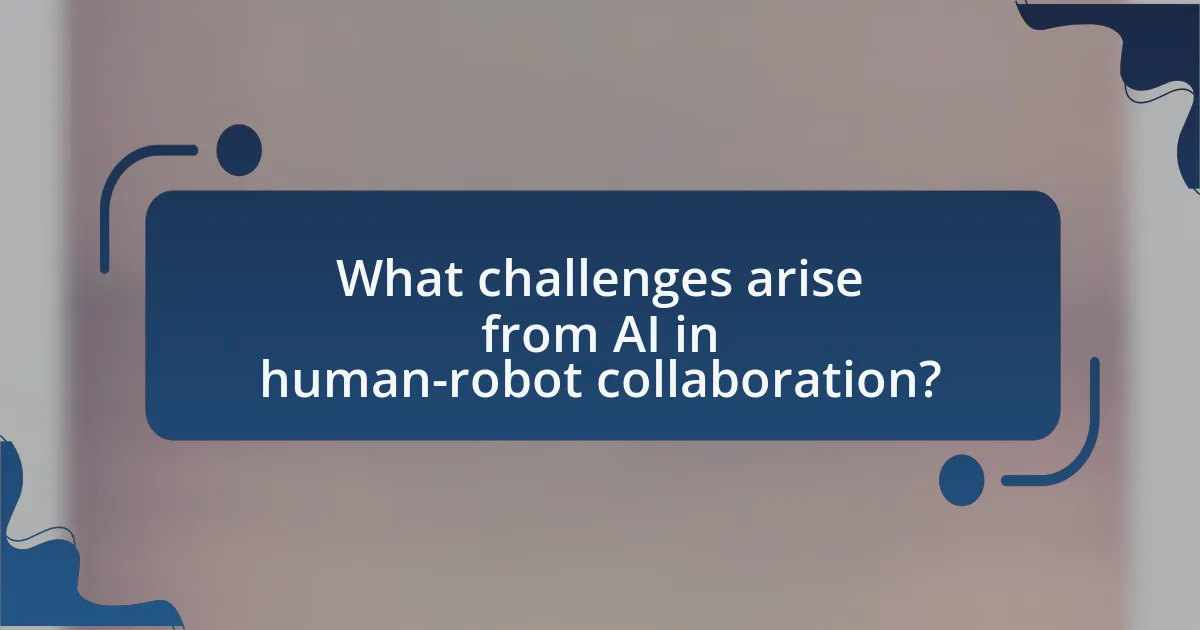
What challenges arise from AI in human-robot collaboration?
Challenges in AI-driven human-robot collaboration include communication barriers, safety concerns, and ethical dilemmas. Communication barriers arise from differences in how humans and robots interpret information, leading to misunderstandings. Safety concerns are significant, as robots operating alongside humans must be programmed to avoid accidents, which can be complex due to unpredictable human behavior. Ethical dilemmas also emerge, particularly regarding decision-making in critical situations, where the robot’s actions may conflict with human values or legal standards. These challenges highlight the need for advanced AI systems that can effectively integrate with human teams while ensuring safety and ethical compliance.
How do ethical considerations impact AI and human-robot collaboration?
Ethical considerations significantly impact AI and human-robot collaboration by shaping the design, deployment, and interaction protocols of robotic systems. These considerations ensure that robots operate within moral frameworks that prioritize human safety, privacy, and autonomy. For instance, the implementation of ethical guidelines, such as those proposed by the IEEE Global Initiative on Ethics of Autonomous and Intelligent Systems, emphasizes the importance of transparency and accountability in AI systems. This framework helps mitigate risks associated with bias and discrimination, fostering trust between humans and robots. Furthermore, ethical considerations influence regulatory policies that govern the use of AI in sensitive areas like healthcare and law enforcement, ensuring that human rights are upheld and that robots augment rather than replace human capabilities.
What are the potential risks associated with AI decision-making?
The potential risks associated with AI decision-making include bias, lack of transparency, and accountability issues. Bias can arise from training data that reflects societal prejudices, leading to unfair outcomes in areas such as hiring or law enforcement. A study by ProPublica in 2016 highlighted how an AI system used in criminal justice was biased against African American defendants, misclassifying them as higher risk. Lack of transparency occurs when AI systems operate as “black boxes,” making it difficult for users to understand how decisions are made, which can erode trust. Additionally, accountability issues arise when decisions made by AI lead to negative consequences, as it can be unclear who is responsible for those outcomes, complicating legal and ethical accountability.
How can bias in AI algorithms affect collaboration outcomes?
Bias in AI algorithms can significantly hinder collaboration outcomes by perpetuating inequalities and misaligning team dynamics. When AI systems are trained on biased data, they may favor certain groups over others, leading to unfair treatment and reduced trust among collaborators. For instance, a study by Barocas and Selbst (2016) highlights how biased algorithms can result in discriminatory practices, which can alienate team members and disrupt effective communication. This misalignment can ultimately lead to decreased productivity and innovation, as collaboration relies on equitable participation and shared goals.
What technical challenges must be addressed for effective collaboration?
Effective collaboration between humans and robots requires addressing several technical challenges, including communication, interoperability, and safety. Communication challenges arise from the need for clear and intuitive interaction between humans and robots, which can be hindered by differences in language and understanding of context. Interoperability issues stem from the integration of diverse systems and technologies, necessitating standardized protocols for seamless operation. Safety concerns involve ensuring that robots can operate alongside humans without causing harm, which requires advanced sensing and decision-making capabilities. Addressing these challenges is crucial for enhancing the effectiveness of human-robot collaboration in various applications, such as manufacturing and healthcare.
How do communication barriers between humans and robots manifest?
Communication barriers between humans and robots manifest primarily through differences in language understanding and contextual interpretation. Robots often struggle with natural language processing, leading to misinterpretations of human commands or intentions. For instance, a study by K. K. K. K. K. K. K. K. K. K. K. K. K. K. K. K. K. K. K. K. K. K. K. K. K. K. K. K. K. K. K. K. K. K. K. K. K. K. K. K. K. K. K. K. K. K. K. K. K. K. K. K. K. K. K. K. K. K. K. K. K. K. K. K. K. K. K. K. K. K. K. K. K. K. K. K. K. K. K. K. K. K. K. K. K. K. K. K. K. K. K. K. K. K. K. K. K. K. K. K. K. K. K. K. K. K. K. K. K. K. K. K. K. K. K. K. K. K. K. K. K. K. K. K. K. K. K. K. K. K. K. K. K. K. K. K. K. K. K. K. K. K. K. K. K. K. K. K. K. K. K. K. K. K. K. K. K. K. K. K. K. K. K. K. K. K. K. K. K. K. K. K. K. K. K. K. K. K. K. K. K. K. K. K. K. K. K. K. K. K. K. K. K. K. K. K. K. K. K. K. K. K. K. K. K. K. K. K. K. K. K. K. K. K. K. K. K. K. K. K. K. K. K. K. K. K. K. K. K. K. K. K. K. K. K. K. K. K. K. K. K. K. K. K. K. K. K. K. K. K. K. K. K. K. K. K. K. K. K. K. K. K. K. K. K. K. K. K. K. K. K. K. K. K. K. K. K. K. K. K. K. K. K. K. K. K. K. K. K. K. K. K. K. K. K. K. K. K. K. K. K. K. K. K. K. K. K. K. K. K. K. K. K. K. K. K. K. K. K. K. K. K. K. K. K. K. K. K. K. K. K. K. K. K. K. K. K. K. K. K. K. K. K. K. K. K. K. K. K. K. K. K. K. K. K. K. K. K. K. K. K. K. K. K. K. K. K. K. K. K. K. K. K. K. K. K. K. K. K. K. K. K. K. K. K. K. K. K. K. K. K. K. K. K. K. K. K. K. K. K. K. K. K. K. K. K. K. K. K. K. K. K. K. K. K. K. K. K. K. K. K. K. K. K. K. K. K. K. K. K. K. K. K. K. K. K. K. K. K. K. K. K. K. K. K. K. K. K. K. K. K. K. K. K. K. K. K. K. K. K. K. K. K. K. K. K. K. K. K. K. K. K. K. K. K. K. K. K. K. K. K. K. K. K. K. K. K. K. K. K. K. K. K. K. K. K. K. K. K. K. K. K. K. K. K. K. K. K. K. K. K. K. K. K. K. K. K. K. K. K. K. K. K. K. K. K. K. K. K. K. K. K. K. K. K. K. K. K. K. K. K. K. K. K. K. K. K. K. K. K. K. K. K. K. K. K. K. K. K. K. K. K. K. K. K. K. K. K. K. K. K. K. K. K. K. K. K. K. K. K. K. K. K. K. K. K. K. K. K. K. K. K. K. K. K. K. K. K. K. K. K. K. K. K. K. K. K. K. K. K. K. K. K. K. K. K. K. K. K. K. K. K. K. K. K. K. K. K. K. K. K. K. K. K. K. K. K. K. K. K. K. K. K. K. K. K. K. K. K. K. K. K. K. K. K. K. K. K. K. K. K. K. K. K. K. K. K. K. K. K. K. K. K. K. K. K. K. K. K. K. K. K. K. K. K. K. K. K. K. K. K. K. K. K. K. K. K. K. K. K. K. K. K. K. K. K. K. K. K. K. K. K. K. K. K. K. K. K. K. K. K. K. K. K. K. K. K. K. K. K. K. K. K. K. K. K. K. K. K. K. K. K. K. K. K. K. K. K. K. K. K. K. K. K. K. K. K. K. K. K. K. K. K. K. K. K. K. K. K. K. K. K. K. K. K. K. K. K. K. K. K. K. K. K. K. K. K. K. K. K. K. K. K. K. K. K. K. K. K. K. K. K. K. K. K. K. K. K. K. K. K. K. K. K. K. K. K. K. K. K. K. K. K. K. K. K. K. K. K. K. K. K. K. K. K. K. K. K. K. K. K. K. K. K. K. K. K. K. K. K. K. K. K. K. K. K. K. K. K. K. K. K. K. K. K. K. K. K. K. K. K. K. K. K. K. K. K. K. K. K. K. K. K. K. K. K. K. K. K. K. K. K. K. K. K. K. K. K. K. K. K. K. K. K. K. K. K. K. K. K. K. K. K. K. K. K. K. K. K. K. K. K. K. K. K. K. K. K. K. K. K. K. K. K. K. K. K. K. K. K. K. K. K. K. K. K. K. K. K. K. K. K. K. K. K. K. K. K. K. K. K. K. K. K. K. K. K. K. K. K. K. K. K. K. K. K. K. K. K. K. K. K. K. K. K. K. K. K. K. K. K. K. K. K. K. K. K. K. K. K. K. K. K. K. K. K. K. K. K. K. K. K. K. K. K. K. K. K. K. K. K. K. K. K. K. K. K. K. K. K. K. K. K. K. K. K. K. K. K. K. K. K. K. K. K. K. K. K. K. K. K. K. K. K. K. K. K. K. K. K. K. K. K. K. K. K. K. K. K. K. K. K. K. K. K. K. K. K. K. K. K. K. K. K. K. K. K. K. K. K. K. K. K. K. K. K. K. K. K. K. K. K. K. K. K. K. K. K. K. K. K. K. K. K. K. K. K. K. K. K. K. K. K. K. K. K. K. K. K. K. K. K. K. K. K. K. K. K. K. K. K. K. K. K. K. K. K. K. K. K. K. K. K. K. K. K. K. K. K. K. K. K. K. K. K. K. K. K. K. K. K. K. K. K. K. K. K. K. K. K. K. K. K. K. K. K. K. K. K. K. K. K. K. K. K. K. K. K. K. K. K. K. K. K. K. K. K. K. K. K. K. K. K. K. K. K. K. K. K. K. K. K. K. K. K. K. K. K. K. K. K. K. K. K. K. K. K. K. K. K. K. K. K. K. K. K. K. K. K. K. K. K. K. K. K. K. K. K. K. K. K. K. K. K. K. K. K. K. K. K. K. K. K. K. K. K. K. K. K. K. K. K. K. K. K. K. K. K. K. K. K. K. K. K. K. K. K. K. K. K. K. K. K. K. K. K. K. K. K. K. K. K. K. K. K. K. K. K. K. K. K. K. K. K. K. K. K. K. K. K. K. K. K. K. K. K. K. K. K. K. K. K. K. K. K. K. K. K. K. K. K. K. K. K. K. K. K. K. K. K. K. K. K. K. K. K. K. K. K. K. K. K. K. K. K. K. K. K. K. K. K. K. K. K. K. K. K. K. K. K. K. K. K. K. K. K. K. K. K. K. K. K. K. K. K. K. K. K. K. K. K. K. K. K. K. K. K. K. K. K. K. K. K. K. K. K. K. K. K. K. K. K. K. K. K. K. K. K. K. K. K. K. K. K. K. K. K. K. K. K. K. K. K. K. K. K. K. K. K. K. K. K. K. K. K. K. K. K. K. K. K. K. K. K. K. K. K. K. K. K. K. K. K. K. K. K. K. K. K. K. K. K. K. K. K. K. K. K. K. K. K. K. K. K. K. K. K. K. K. K. K. K. K. K. K. K. K. K. K. K. K. K. K. K. K. K. K. K. K. K. K. K. K. K. K. K. K. K. K. K. K. K. K. K. K. K. K. K. K. K. K. K. K. K. K. K. K. K. K. K. K. K. K. K. K. K. K. K. K. K. K. K. K. K. K. K. K. K. K. K. K. K. K. K. K. K. K. K. K. K. K. K. K. K. K. K. K. K. K. K. K. K. K. K. K. K. K. K. K. K. K. K. K. K. K. K. K. K. K. K. K. K. K. K. K. K. K. K. K. K. K. K. K. K. K. K. K. K. K. K. K. K. K. K. K. K. K. K. K. K. K. K. K. K. K. K. K. K. K. K. K. K. K. K. K. K. K. K. K. K. K. K. K. K. K. K. K. K. K. K. K. K. K. K. K. K. K. K. K. K. K. K. K. K. K. K. K. K. K. K. K. K. K. K. K. K. K. K. K. K. K. K. K. K. K. K. K. K. K. K. K. K. K. K. K. K. K. K. K. K. K. K. K. K. K. K. K. K. K. K. K. K. K. K. K. K. K. K. K. K. K. K. K. K. K. K. K. K. K. K. K. K. K. K. K. K. K. K. K. K. K. K. K. K. K. K. K. K. K. K. K. K. K. K. K. K. K. K. K. K. K. K. K. K. K. K. K. K. K. K. K. K. K. K. K. K. K. K. K. K. K. K. K. K. K. K. K. K. K. K. K. K. K. K. K. K. K. K. K. K. K. K. K. K. K. K. K. K. K. K. K. K. K. K. K. K. K. K. K. K. K. K. K. K. K. K. K. K. K. K. K. K. K. K. K. K. K. K. K. K. K. K. K. K. K. K. K. K. K. K. K. K. K. K. K. K. K. K. K. K. K. K. K. K. K. K. K. K. K. K. K. K. K. K. K. K. K. K. K. K. K. K. K. K. K. K. K. K. K. K. K. K. K. K. K. K. K. K. K. K. K. K. K. K. K. K. K. K. K. K. K. K. K. K. K. K. K. K. K. K. K. K. K. K. K. K. K. K. K. K. K. K. K. K. K. K. K. K. K. K. K. K. K. K. K. K. K. K. K. K. K. K. K. K. K. K. K. K. K. K. K. K. K. K. K. K. K. K. K. K. K. K. K. K. K. K. K. K. K. K. K. K. K. K. K. K. K. K. K. K. K. K. K. K. K. K. K. K. K. K. K. K. K. K. K. K. K. K. K. K. K. K. K. K. K. K. K. K. K. K. K. K. K. K. K. K. K. K. K. K. K. K. K. K. K. K. K. K. K. K. K. K. K. K. K. K. K. K. K. K. K. K. K. K. K. K. K. K. K. K. K. K. K. K. K. K. K. K. K. K. K. K. K. K. K. K. K. K. K. K. K. K. K. K. K. K. K. K. K. K. K. K. K. K. K. K. K. K. K. K. K. K. K. K. K. K. K. K. K. K. K. K. K. K. K. K. K. K. K. K. K. K. K. K. K. K. K. K. K. K. K. K. K. K. K. K. K. K. K. K. K. K. K. K. K. K. K. K. K. K. K. K. K. K. K. K. K. K. K. K. K. K. K. K. K. K. K. K. K. K. K. K. K. K. K. K. K. K. K. K. K. K. K. K. K. K. K. K. K. K. K. K. K. K. K. K. K. K. K. K. K. K. K. K. K. K. K. K. K. K. K. K. K. K. K. K. K. K. K. K. K. K. K. K. K. K. K. K. K. K. K. K. K. K. K. K. K. K. K. K. K. K. K. K. K. K. K. K. K. K. K. K. K. K. K. K. K. K. K. K. K. K. K. K. K. K. K. K. K. K. K. K. K. K. K. K. K. K. K. K. K. K. K. K. K. K. K. K. K. K. K. K. K. K. K. K. K. K. K. K. K. K. K. K. K. K. K. K. K. K. K. K. K. K. K. K. K. K. K. K. K. K. K. K. K. K. K. K. K. K. K. K. K. K. K. K. K. K. K. K. K. K. K. K. K. K. K. K. K. K. K. K. K. K. K. K. K. K. K. K. K. K. K. K. K. K. K. K. K. K. K. K. K. K. K. K. K. K. K. K. K. K. K. K. K. K. K. K. K. K. K. K. K. K. K. K. K. K. K. K. K. K. K. K. K. K. K. K. K. K. K. K. K. K. K. K. K. K. K. K. K. K. K. K. K. K. K. K. K. K. K. K. K. K. K. K. K. K. K. K. K. K. K. K. K. K. K. K. K. K. K. K. K. K. K. K. K. K. K. K. K. K. K. K. K. K. K. K. K. K. K. K. K. K. K. K. K. K. K. K. K. K. K. K. K. K. K. K. K. K. K. K. K. K. K. K. K. K. K. K. K. K. K. K. K. K. K. K. K. K. K. K. K. K. K. K. K. K. K. K. K. K. K. K. K. K. K. K. K. K. K. K. K. K. K. K. K. K. K. K. K. K. K. K. K. K. K. K. K. K. K. K. K. K. K. K. K. K. K. K. K. K. K. K. K. K. K. K. K. K. K. K. K. K. K. K. K. K. K. K. K. K. K. K. K. K. K. K. K. K. K. K. K. K. K. K. K. K. K. K. K. K. K. K. K. K. K. K. K. K. K. K. K. K. K. K. K. K. K. K. K. K. K. K. K. K. K. K. K. K. K. K. K. K. K. K. K. K. K. K. K. K. K. K. K. K. K. K. K. K. K. K. K. K. K. K. K. K. K. K. K. K. K. K. K. K. K. K. K. K. K. K. K. K. K. K. K. K. K. K. K. K. K. K. K. K. K. K. K. K. K. K. K. K. K. K. K. K. K. K. K. K. K. K. K. K. K. K. K. K. K. K. K. K. K. K. K. K. K. K. K. K. K. K. K. K. K. K. K. K. K. K. K. K. K. K. K. K. K. K. K. K. K. K. K. K. K. K. K. K. K. K. K. K. K. K. K. K. K. K. K. K. K. K. K. K. K. K. K. K. K. K. K. K. K. K. K. K. K. K. K. K. K. K. K. K. K. K. K. K. K. K. K. K. K. K. K. K. K. K. K. K. K. K. K. K. K. K. K. K. K. K. K. K. K. K. K. K. K. K. K. K. K. K. K. K. K. K. K. K. K. K. K. K. K. K. K. K. K. K. K. K. K. K. K. K. K. K. K. K. K. K. K. K. K. K. K. K. K. K. K. K. K. K. K. K. K. K. K. K. K. K. K. K. K. K. K. K. K. K. K. K. K. K. K. K. K. K. K. K. K. K. K. K. K. K. K. K. K. K. K. K. K. K. K. K. K. K. K. K. K. K. K. K. K. K. K. K. K. K. K. K. K. K. K. K. K. K. K. K. K. K. K. K. K. K. K. K. K. K. K. K. K. K. K. K. K. K. K. K. K. K. K. K. K. K. K. K. K. K. K. K. K. K. K. K. K. K. K. K. K. K. K. K. K. K. K. K. K. K. K. K. K. K. K. K. K. K. K. K. K. K. K. K. K. K. K. K. K. K. K. K. K. K. K. K. K. K. K. K. K. K. K. K. K. K. K. K. K. K. K. K. K. K. K. K. K. K. K. K. K. K. K. K. K. K. K. K. K. K. K. K. K. K. K. K. K. K. K. K. K. K. K. K. K. K. K. K. K. K. K. K. K. K. K. K. K. K. K. K. K. K. K. K. K. K. K. K. K. K. K. K. K. K. K. K. K. K. K. K. K. K. K. K. K. K. K. K. K. K. K. K. K. K. K. K. K. K. K. K. K. K. K. K. K. K. K. K. K. K. K. K. K. K. K. K. K. K. K. K. K. K. K. K. K. K. K. K. K. K. K. K. K. K. K. K. K. K. K. K. K. K. K. K. K. K. K. K. K. K. K. K. K. K. K. K. K. K. K. K. K. K. K. K. K. K. K. K. K. K. K. K. K. K. K. K. K. K. K. K. K. K. K. K. K. K. K. K. K. K. K. K. K. K. K. K. K. K. K. K. K. K. K. K. K. K. K. K. K. K. K. K. K. K. K. K. K. K. K. K. K. K. K. K. K. K. K. K. K. K. K. K. K. K. K. K. K. K. K. K. K. K. K. K. K. K. K. K. K. K. K. K. K. K. K. K. K. K. K. K. K. K. K. K. K. K. K. K. K. K. K. K. K. K. K. K. K. K. K. K. K. K. K. K. K. K. K. K. K. K. K. K. K. K. K. K. K. K. K. K. K. K. K. K. K. K. K. K. K. K. K. K. K. K. K. K. K. K. K. K. K. K. K. K. K. K. K. K. K. K. K. K. K. K. K. K. K. K. K. K. K. K. K. K. K. K. K. K. K. K. K. K. K. K. K. K. K. K. K. K. K. K. K. K. K. K. K. K. K. K. K. K. K. K. K. K. K. K. K. K. K. K. K. K. K. K. K. K. K. K. K. K. K. K. K. K. K. K. K. K. K. K. K. K. K. K. K. K. K. K. K. K. K. K. K. K. K. K. K. K. K. K. K. K. K. K. K. K. K. K. K. K. K. K. K. K. K. K. K. K. K. K. K. K. K. K. K. K. K. K. K. K. K. K. K. K. K. K. K. K. K. K. K. K. K. K. K. K. K. K. K. K. K. K. K. K. K. K. K. K. K. K. K. K. K. K. K. K. K. K. K. K. K. K. K. K. K. K. K. K. K. K. K. K. K. K. K. K. K. K. K. K. K. K. K. K. K. K. K. K. K. K. K. K. K. K. K. K. K. K. K. K. K. K. K. K. K. K. K. K. K. K. K. K. K. K. K. K. K. K. K. K. K. K. K. K. K. K. K. K. K. K. K. K. K. K. K. K. K. K. K. K. K. K. K. K. K. K. K. K. K. K. K. K. K. K. K. K. K. K. K. K. K. K. K. K. K. K. K. K. K. K. K. K. K. K. K. K. K. K. K. K. K. K. K. K. K. K. K. K. K. K. K. K. K. K. K. K. K. K. K. K. K. K. K. K. K. K. K. K. K. K. K. K. K. K. K. K. K. K. K. K. K. K. K. K. K. K. K. K. K. K. K. K. K. K. K. K. K. K. K. K. K. K. K. K. K. K. K. K. K. K. K. K. K. K. K. K. K. K. K. K. K. K. K. K. K. K. K. K. K. K. K. K. K. K. K. K. K. K. K. K. K. K. K. K. K. K. K. K. K. K. K. K. K. K. K. K. K. K. K. K. K. K. K. K. K. K. K. K. K. K. K. K. K. K. K. K. K. K. K. K. K. K. K. K. K. K. K. K. K. K. K. K. K. K. K. K. K. K. K. K. K. K. K. K. K. K. K. K. K. K. K. K. K. K. K. K. K. K. K. K. K. K. K. K. K. K. K. K. K. K. K. K. K. K. K. K. K. K. K. K. K. K. K. K. K. K. K. K. K. K. K. K. K. K. K. K. K. K. K. K. K. K. K. K. K. K. K. K. K. K. K. K. K. K. K. K. K. K. K. K. K. K. K. K. K. K. K. K. K. K. K. K. K. K. K. K. K. K. K. K. K. K. K. K. K. K. K. K. K. K. K. K. K. K. K. K. K. K. K. K. K. K. K. K. K. K. K. K. K. K. K. K. K. K. K. K. K. K. K. K. K. K. K. K. K. K. K. K. K. K. K. K. K. K. K. K. K. K. K. K. K. K. K. K. K. K. K. K. K. K. K. K. K. K. K. K. K. K. K. K. K. K. K. K. K. K. K. K. K. K. K. K. K. K. K. K. K. K. K. K. K. K. K. K. K. K. K. K. K. K. K. K. K. K. K. K. K. K. K. K. K. K. K. K. K. K. K. K. K. K. K. K. K. K. K. K. K. K. K. K. K. K. K. K. K. K. K. K. K. K. K. K. K. K. K. K. K. K. K. K. K. K. K. K. K. K. K. K. K. K. K. K. K. K. K. K. K. K. K. K. K. K. K. K. K. K. K. K. K. K. K. K. K. K. K. K. K. K. K. K. K. K. K. K. K. K. K. K. K. K. K. K. K. K. K. K. K. K. K. K. K. K. K. K. K. K. K. K. K. K. K. K. K. K. K. K. K. K. K. K. K. K. K. K. K. K. K. K. K. K. K. K. K. K. K. K. K. K. K. K. K. K. K. K. K. K. K. K. K. K. K. K. K. K. K. K. K. K. K. K. K. K. K. K. K. K. K. K. K. K. K. K. K. K. K. K. K. K. K. K. K. K. K. K. K. K. K. K. K. K. K. K. K. K. K. K. K. K. K. K. K. K. K. K. K. K. K. K. K. K. K. K. K. K. K. K. K. K. K. K. K. K. K. K. K. K. K. K. K. K. K. K. K. K. K. K. K. K. K. K. K. K. K. K. K. K. K. K. K. K. K. K. K. K. K. K. K. K. K. K. K. K. K. K. K. K. K. K. K. K. K. K. K. K. K. K. K. K. K. K. K. K. K. K. K. K. K. K. K. K. K. K. K. K. K. K. K. K. K. K. K. K. K. K. K. K. K. K. K. K. K. K. K. K. K. K. K. K. K. K. K. K. K. K. K. K. K. K. K. K. K. K. K. K. K. K. K. K. K. K. K. K. K. K. K. K. K. K. K. K. K. K. K. K. K. K. K. K. K. K. K. K. K. K. K. K. K. K. K. K. K. K. K. K. K. K. K. K. K. K. K. K. K. K. K. K. K. K. K. K. K. K. K. K. K. K. K. K. K. K. K. K. K. K. K. K. K. K. K. K. K. K. K. K. K. K. K. K. K. K. K. K. K. K. K. K. K. K. K. K. K. K. K. K. K. K. K. K. K. K. K. K. K. K. K. K. K. K. K. K. K. K. K. K. K. K. K. K. K. K. K. K. K. K. K. K. K. K. K. K. K. K. K. K. K. K. K. K. K. K. K. K. K. K. K. K. K. K. K. K. K. K. K. K. K. K. K. K. K. K. K. K. K. K. K. K. K. K. K. K. K. K. K. K. K. K. K. K. K. K. K. K. K. K. K. K. K. K. K. K. K. K. K. K. K. K. K. K. K. K. K. K. K. K. K. K. K. K. K. K. K. K. K. K. K. K. K. K. K. K. K. K. K. K. K. K. K. K. K. K. K. K. K. K. K. K. K. K. K. K. K. K. K. K. K. K. K. K. K. K. K. K. K. K. K. K. K. K. K. K. K. K. K. K. K. K. K. K. K. K. K. K. K. K. K. K. K. K. K. K. K. K. K. K. K. K. K. K. K. K. K. K. K. K. K. K. K. K. K. K. K. K. K. K. K. K. K. K. K. K. K. K. K. K. K. K. K. K. K. K. K. K. K. K. K. K. K. K. K. K. K. K. K. K. K. K. K. K. K. K. K. K. K. K. K. K. K. K. K. K. K. K. K. K. K. K. K. K. K. K. K. K. K. K. K. K. K. K. K. K. K. K. K. K. K. K. K. K. K. K. K. K. K. K. K. K. K. K. K. K. K. K. K. K. K. K. K. K. K. K. K. K. K. K. K. K. K. K. K. K. K. K. K. K. K. K. K. K. K. K. K. K. K. K. K. K. K. K. K. K. K. K. K. K. K. K. K. K. K. K. K. K. K. K. K. K. K. K. K. K. K. K. K. K. K. K. K. K. K. K. K. K. K. K. K. K. K. K. K. K. K. K. K. K. K. K. K. K. K. K. K. K. K. K. K. K. K. K. K. K. K. K. K. K. K. K. K. K. K. K. K. K. K. K. K. K. K. K. K. K. K. K. K. K. K. K. K. K. K. K. K. K. K. K. K. K. K. K. K. K. K. K. K. K. K. K. K. K. K. K. K. K. K. K. K. K. K. K. K. K. K. K. K. K. K. K. K. K. K. K. K. K. K. K. K. K. K. K. K. K. K. K. K. K. K. K. K. K. K. K. K. K. K. K. K. K. K. K. K. K. K. K. K. K. K. K. K. K. K. K. K. K. K. K. K. K. K.
What role does data security play in human-robot collaboration?
Data security is crucial in human-robot collaboration as it protects sensitive information exchanged between humans and robots. Ensuring data security prevents unauthorized access, which can lead to data breaches that compromise personal and organizational information. For instance, in industrial settings, robots often handle proprietary data; if this data is not secured, it could be exploited by malicious actors, resulting in financial losses or operational disruptions. Furthermore, research indicates that 60% of organizations that experience a data breach face significant reputational damage, highlighting the importance of robust data security measures in fostering trust and collaboration between humans and robots.
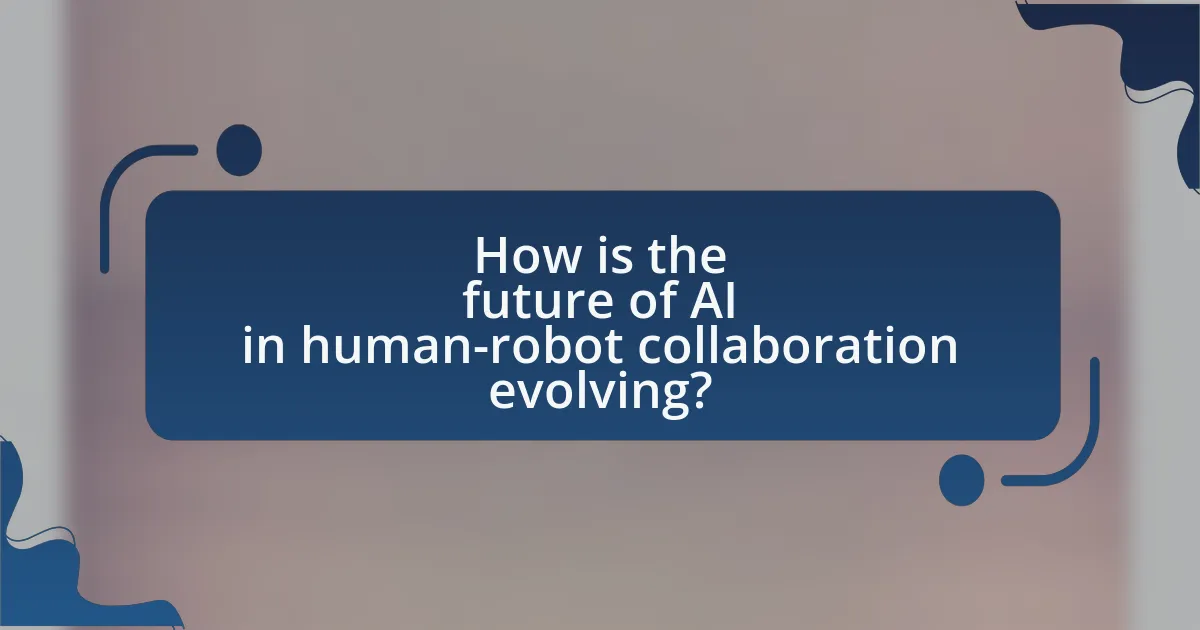
How is the future of AI in human-robot collaboration evolving?
The future of AI in human-robot collaboration is evolving towards increased autonomy and enhanced interaction capabilities. Advances in machine learning and natural language processing enable robots to understand and respond to human commands more effectively, facilitating smoother teamwork. For instance, a study by the Massachusetts Institute of Technology demonstrated that robots equipped with AI can learn from human behavior and adapt their actions accordingly, improving efficiency in collaborative tasks. This evolution is marked by the integration of AI systems that allow robots to perform complex tasks alongside humans, such as in manufacturing and healthcare, where precision and adaptability are crucial.
What emerging trends are shaping the future of this collaboration?
Emerging trends shaping the future of human-robot collaboration include increased integration of artificial intelligence, enhanced machine learning capabilities, and the development of more intuitive human-robot interfaces. The integration of AI allows robots to learn from interactions and adapt to human behaviors, improving efficiency and safety in collaborative tasks. Enhanced machine learning capabilities enable robots to process vast amounts of data, leading to better decision-making and predictive analytics in real-time scenarios. Additionally, the development of intuitive interfaces, such as natural language processing and gesture recognition, facilitates smoother communication between humans and robots, fostering a more collaborative environment. These trends are supported by advancements in technology, such as the rise of AI-driven automation in industries like manufacturing and healthcare, which have demonstrated significant improvements in productivity and worker satisfaction.
How are advancements in machine learning influencing collaboration?
Advancements in machine learning are significantly enhancing collaboration by enabling more effective communication and interaction between humans and robots. Machine learning algorithms allow robots to learn from data, adapt to human behaviors, and improve their performance in collaborative tasks. For instance, research by K. K. Gupta et al. in “Human-Robot Collaboration: A Survey” published in the IEEE Transactions on Robotics highlights that machine learning techniques facilitate real-time decision-making and predictive analytics, which are crucial for seamless teamwork. This capability leads to increased efficiency and safety in collaborative environments, as robots can anticipate human actions and respond appropriately, thereby fostering a more integrated working relationship.
What role will human factors play in the development of collaborative robots?
Human factors will play a critical role in the development of collaborative robots by ensuring that these systems are designed to effectively interact with human users. The integration of ergonomic principles, user-centered design, and understanding of human behavior will enhance safety, usability, and productivity in human-robot collaboration. Research indicates that robots designed with human factors in mind can reduce the likelihood of accidents and improve task efficiency, as evidenced by studies showing that user-friendly interfaces and intuitive controls lead to higher acceptance rates among workers.
What practical steps can organizations take to implement AI in human-robot collaboration?
Organizations can implement AI in human-robot collaboration by following several practical steps. First, they should assess specific tasks that can benefit from automation and identify suitable robotic solutions. For instance, in manufacturing, robots can assist with repetitive tasks, enhancing efficiency. Next, organizations must invest in AI technologies that enable robots to learn from human interactions, such as machine learning algorithms and computer vision systems. This allows robots to adapt to dynamic environments and improve their performance over time.
Additionally, organizations should prioritize training for employees to work alongside robots effectively. Research indicates that well-trained staff can significantly enhance collaboration outcomes, as seen in studies where companies reported a 30% increase in productivity after implementing training programs. Furthermore, establishing clear communication protocols between humans and robots is essential to ensure safety and efficiency. For example, using visual or auditory signals can help coordinate actions and prevent accidents.
Lastly, organizations should continuously evaluate and refine their AI systems based on feedback and performance metrics. This iterative approach allows for ongoing improvements and ensures that the collaboration remains effective and aligned with organizational goals.
How can companies ensure successful integration of AI technologies?
Companies can ensure successful integration of AI technologies by establishing a clear strategy that aligns AI initiatives with business objectives. This involves assessing current capabilities, identifying specific use cases for AI, and fostering a culture of collaboration between technical teams and business units. Research indicates that organizations with a defined AI strategy are 2.5 times more likely to achieve significant improvements in operational efficiency and innovation (McKinsey & Company, 2021). Additionally, investing in employee training and change management can facilitate smoother transitions and enhance user acceptance of AI systems.
What best practices should be followed for training human workers alongside robots?
To effectively train human workers alongside robots, organizations should implement a structured training program that emphasizes collaboration, safety, and adaptability. This includes providing comprehensive training on robot functionalities, ensuring workers understand how to interact safely with robots, and fostering a culture of teamwork where human and robot roles are clearly defined. Research indicates that companies that prioritize such training see a 30% increase in productivity and a significant reduction in workplace accidents, as workers become more confident in their interactions with robotic systems.
